| Tuesday | Tuesday Night | Wednesday | |
|---|---|---|---|
| Weather: | Sunny with some clouds developing during the day | Partly cloudy | Mostly cloudy with a slight chance of snow in the afternoon |
| Temperatures: | 40 to 45 deg. F. | 25 to 30 deg. F. | 40 to 45 deg. F. |
| Mid Slope Winds: | Variable | Southwest | Southwest |
| Wind Speed: | Light | 10 to 15 mph with gusts to 30 mph increasing to 45 mph after midnight | 20 to 30 mph with gusts to 65 mph increasing to 30 to 45 mph with gusts to 80 mph in the afternoon |
| Expected snowfall: | 0 | 0 | up to 1 |
| Tuesday | Tuesday Night | Wednesday | |
|---|---|---|---|
| Weather: | Sunny with some clouds developing during the day | Partly cloudy | Mostly cloudy with a slight chance of snow in the afternoon |
| Temperatures: | 37 to 42 deg. F. | 24 to 29 deg. F. | 34 to 40 deg. F. |
| Ridge Top Winds: | Southwest | Southwest shifting to the south after midnight | Southwest |
| Wind Speed: | 10 to 15 mph with gusts to 30 mph | 15 to 25 mph with gusts to 45 mph increasing to 20 to 35 mph with gusts to 70 mph | 35 to 55 mph with gusts to 100 mph increasing to 45 to 65 mph with gusts to 110 mph in the afternoon |
| Expected snowfall: | 0 | 0 | up to 1 |
























